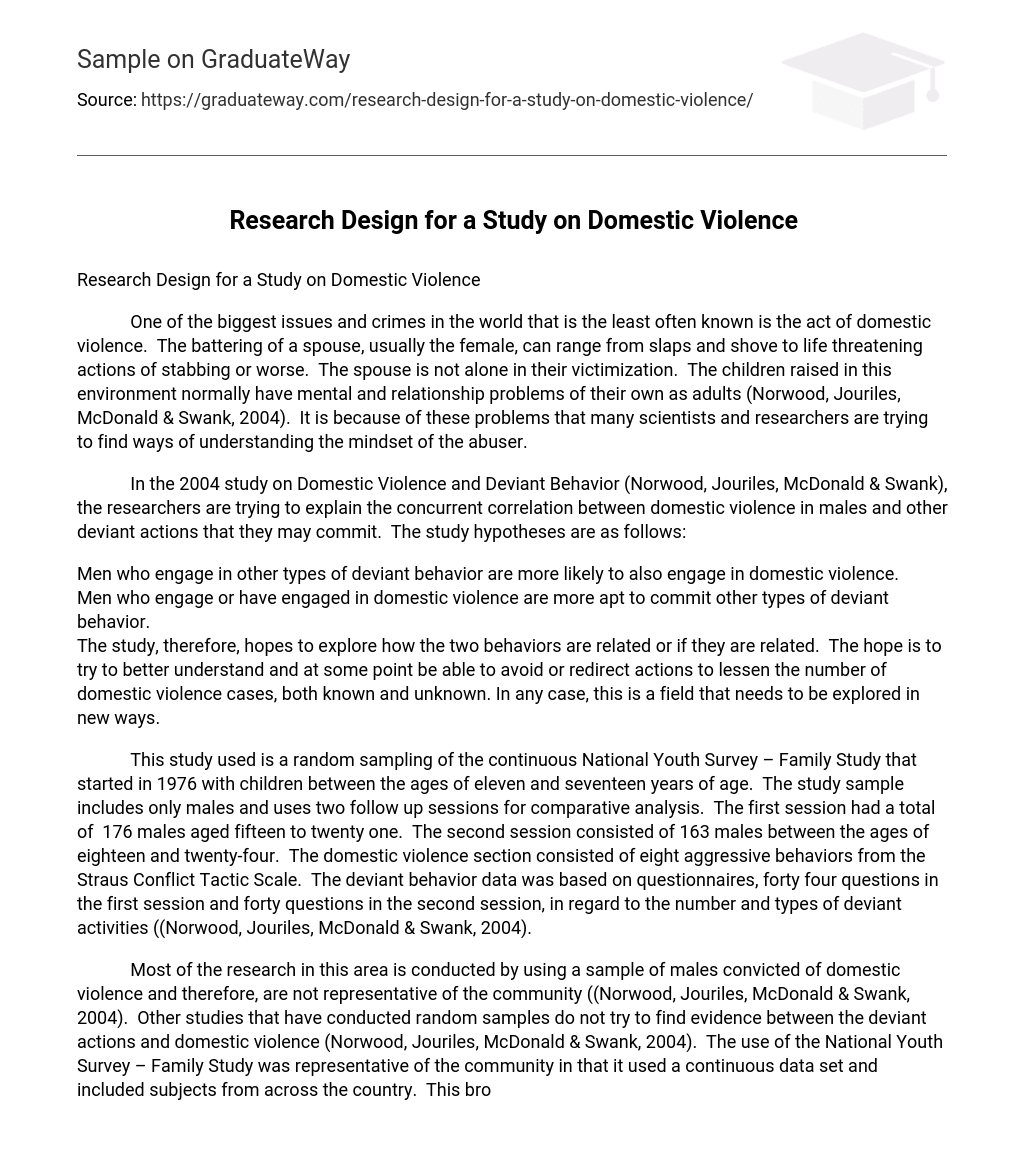One of the biggest issues and crimes in the world that is the least often known is the act of domestic violence. The battering of a spouse, usually the female, can range from slaps and shove to life threatening actions of stabbing or worse. The spouse is not alone in their victimization. The children raised in this environment normally have mental and relationship problems of their own as adults (Norwood, Jouriles, McDonald & Swank, 2004). It is because of these problems that many scientists and researchers are trying to find ways of understanding the mindset of the abuser.
In the 2004 study on Domestic Violence and Deviant Behavior (Norwood, Jouriles, McDonald & Swank), the researchers are trying to explain the concurrent correlation between domestic violence in males and other deviant actions that they may commit. The study hypotheses are as follows:
Men who engage in other types of deviant behavior are more likely to also engage in domestic violence.
Men who engage or have engaged in domestic violence are more apt to commit other types of deviant behavior.
The study, therefore, hopes to explore how the two behaviors are related or if they are related. The hope is to try to better understand and at some point be able to avoid or redirect actions to lessen the number of domestic violence cases, both known and unknown. In any case, this is a field that needs to be explored in new ways.
This study used is a random sampling of the continuous National Youth Survey – Family Study that started in 1976 with children between the ages of eleven and seventeen years of age. The study sample includes only males and uses two follow up sessions for comparative analysis. The first session had a total of 176 males aged fifteen to twenty one. The second session consisted of 163 males between the ages of eighteen and twenty-four. The domestic violence section consisted of eight aggressive behaviors from the Straus Conflict Tactic Scale. The deviant behavior data was based on questionnaires, forty four questions in the first session and forty questions in the second session, in regard to the number and types of deviant activities ((Norwood, Jouriles, McDonald & Swank, 2004).
Most of the research in this area is conducted by using a sample of males convicted of domestic violence and therefore, are not representative of the community ((Norwood, Jouriles, McDonald & Swank, 2004). Other studies that have conducted random samples do not try to find evidence between the deviant actions and domestic violence (Norwood, Jouriles, McDonald & Swank, 2004). The use of the National Youth Survey – Family Study was representative of the community in that it used a continuous data set and included subjects from across the country. This broad bases give a much better representation of the trends of domestic violence and deviant behavior in the United States Most of the research in this area is conducted by using a sample of males convicted of domestic violence and therefore, are not representative of the community ((Norwood, Jouriles, McDonald & Swank, 2004). Other studies that have conducted random samples do not try to find evidence between the deviant actions and domestic violence in the United States (Norwood, Jouriles, McDonald & Swank, 2004).
This study is a general study and did not focus on the types of deviant behavior that correlates to the behavior of domestic violence. The actions were either yes or no to behaving deviantly and yes or no to committing domestic violence. More research should be conducted to delve deeper into the types of deviant behavior that have the strongest correlation between the two actions. This study showed a high correlation between deviance and domestic violence, but could not explain the types of deviant behavior. One would assume substance abuse, violent crimes, and fighting would probably be actions that could relate to domestic violence, but until the research is conducted using a national representation, any speculation is just that, speculation. The other factor that should be considered is if any of the subjects grew up in a household with domestic violence and how that influenced their own actions toward their partners and their possible deviant actions. This one study just sets the stage for more research to get a clearer picture of the influences and causes of domestic violence and deviant behavior.
References
Norwood, W. D., Jouriles, E. N., McDonald, R., & Swank, P. R. (2004). Domestic Violence and Deviant Behavior. Washington, DC: National Institute of Justice/NCJRS. Retrieved March 14, 2009 from http://www.ncjrs.gov/pdffiles1/nij/199713.pdf





